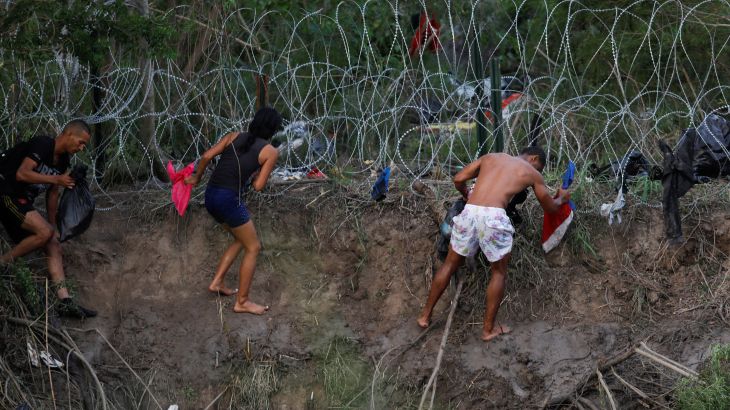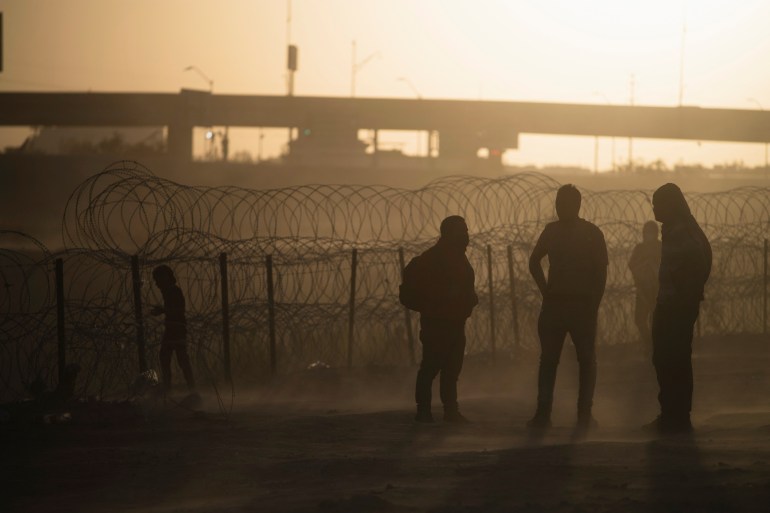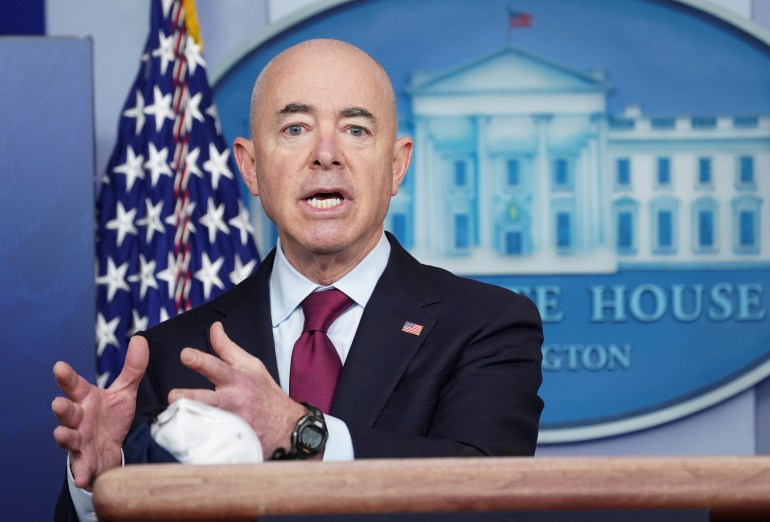Confusion, resolve at US-Mexico border as Title 42 formally ends
Experts say new restrictions at US-Mexico border will continue to impede access to asylum as contentious policy expires.

A contentious United States policy that has allowed authorities to turn away most asylum seekers at the border with Mexico has officially ended, as President Joe Biden’s administration readies for an expected influx of arrivals.
The public health order known as Title 42, which formally expired at 11:59pm on Thursday (03:59 GMT on Friday), had been used to turn asylum seekers away more than 2.8 million times since it was first invoked in March 2020.
Keep reading
list of 3 itemsWhat to expect as Biden sends 1,500 troops to US-Mexico border
It’s psychological warfare season on the US border
At the time, then-President Donald Trump argued Title 42 was necessary to curb the spread of COVID-19, but rights groups immediately criticised the measure, saying the pandemic was merely a pretext to crack down on immigration.
The policy’s expiration coincided with the end of the federal COVID-19 public health emergency on May 11, and the Biden administration has sent additional troops and resources to the US-Mexico border in advance of its end.
Washington also finalised a new rule this week that will make most refugees and asylum seekers arriving at the country’s southern border with Mexico ineligible to seek asylum in the US. The rule will take effect when Title 42 expires.
People seeking to immigrate have rushed across the border in the days and hours before the policy was set to end, fearing that the new policy would make it far more difficult to gain entry into the US.

In the Mexican border town of Matamoros, across from Brownsville, Texas, people arrived steadily on Wednesday, stripping down before descending a steep bank clutching plastic bags filled with clothes. They slowly waded into the river, one man holding a baby in an open suitcase on his head.
On the US side, they put on dry clothing and picked their way through concertina wire. Many surrendered to authorities, hoping to be released to stay legally while pursuing their cases in backlogged immigration courts, a process which can take years.
At the border wall in San Ysidro, California, across from Tijuana, Mexico, hundreds of people crossed on Wednesday and were waiting to be processed by US authorities. The group included families with young children and people from Colombia, Brazil, Afghanistan and Turkey.
Members of the American Friends Service Committee, a Quaker charity, handed out silver, reflective blankets to keep people warm in the freezing temperatures at night. Some asylum seekers started campfires.
Angelica, an Indigenous woman from Colombia who did not want her last name used for fear of reprisals, said she spent two nights sleeping on the ground in hopes of claiming asylum in the US.
She told Al Jazeera that she took several flights from Colombia to Mexico, and when she reached Tijuana, she climbed over the border wall. She said she was seeking asylum because criminals in Colombia have threatened her but did not know what would happen next at the border.
“I will have to wait and see what happens,” Angelica said in a WhatsApp message on Thursday from the border. “I only know that I have a mission and a vision. I hope I can [ask for asylum] soon.”
US defends policies
While rights groups had called for Title 42 to be rescinded, they also condemned the Biden administration for increasingly leaning on policies that will also deny refuge to people fleeing desperate circumstances.
Many of the people seeking asylum at the US’s southern border are fleeing widespread violence, political instability and socioeconomic crises in their home countries in Central and South America, as well as in countries such as China, Turkey, Russia and elsewhere.
Al Jazeera’s Teresa Bo, reporting from the Haitian capital of Port-au-Prince, said the US policy change was unlikely to dissuade people from trying to leave the Caribbean nation amid widespread gang violence and hunger.
“On Wednesday, we were able to go to a government office where people were waiting for their passports, hundreds and hundreds of them,” Bo said. “And they were telling us that they do not know what Title 42 is, that they’re just trying to leave the country in order to feel safe.
“And that’s what you hear among the population here: They’re desperate to leave and to feel safe once again.”

The Biden administration has defended its policies, however, stressing this week that its approach to immigration is centred on “enforcement, deterrence and diplomacy”.
“Right now, we believe we have a robust plan, a multi-agency plan, to do this in a humane way,” White House spokesperson Karine Jean-Pierre told reporters in response to questions on Tuesday about what the US was doing at the border to prepare for the end of Title 42.
Washington has urged prospective immigrants to take “legal pathways” to get to the country, including applying through an app known as CBP One and using new programmes that allow a limited number of asylum seekers that meet certain criteria to enter the US.
“President Biden has led the largest expansion of lawful pathways in decades,” Secretary of Homeland Security Alejandro Mayorkas said at a White House briefing on Thursday.
However, Mayorkas said the new asylum rule would mean tougher consequences for migrants and refugees crossing irregularly, who could be deported and barred from the US for five years if they do not qualify for protection.
“The transition to Title 8 processing will be swift and immediate,” he said of the new policy, stressing that anyone who is removed will be “subject to at least a five-year ban on re-entry into the United States and can face criminal prosecution if they attempt to cross again”.
Mayorkas also announced during a news conference on Wednesday that the Biden administration was launching a “digital advertising campaign in Central and South America to counter the lies of the smugglers” who bring people to the border.
“Smugglers have been long hard at work spreading false information that the border will be open. They are lying,” he said on Thursday. “To people who are thinking of making the journey to our southern border, know this: Smugglers care only about profits, not people. Do not risk your life and your life’s savings only to be removed from the United States if and when you arrive here.”
Thousands apprehended
The Biden administration has been under political pressure to respond to increased arrivals at the border, as Republican legislators blamed the Democratic president for the influx since he took office in January 2021.
Already, daily apprehensions at the US-Mexico border surpassed 10,000 on Monday and Tuesday, according to US officials, and American border cities have struggled to shelter new arrivals.
On Wednesday morning, US Customs and Border Protection (CBP) had more than 28,000 people in custody, marking what appeared to be a record, a US official said, requesting anonymity to discuss internal operations. He also noted that those numbers far exceeded the agency’s stated capacity.
In Texas this week, Republican Governor Greg Abbott — a staunch critic of Biden’s immigration policies — said he was deploying a special border force to target “hot spots” along the border in anticipation of the end of Title 42.
But on Thursday, Mayorkas blamed any chaos at the border on the failure of leaders in the US Congress to fix “a fundamentally broken immigration system”.
“This is an ongoing challenge that quite frankly has vexed this country for decades, because Congress has been unable to pass immigration reform that everyone agrees and understands is desperately needed,” the Homeland Security secretary said.

“We are working with an immigration system that was last reformed in the 1990s. Migration has changed dramatically since then, and we need our laws updated.”
Oscar Leeser, mayor of El Paso, which is routinely one of the busiest crossings on the border, said the Texas city was preparing for an influx of arrivals. Several cities along the border, including El Paso, have already issued emergency declarations for their area.
“But we don’t know what’s coming in the next day. We don’t know what’s coming in the next 10 days,” Leeser said. “We know that they’ll continue to come, and we’ll continue to make sure that we help them.”
Hilary Beaumont contributed reporting from San Ysidro, California.